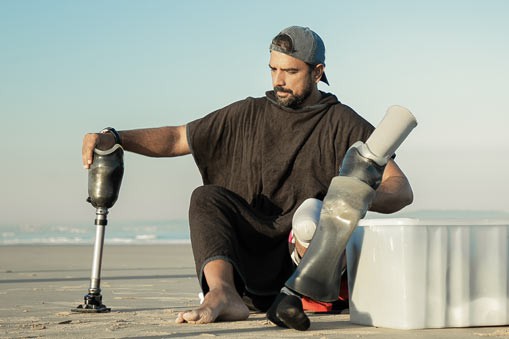Liners and Shrinkers and Socks, Oh My!
One of my favorite movies is "The Wizard of Oz". A scene that always sticks out to me is when Dorothy, Tin Man and Scarecrow are going through the woods and discussing what they might encounter. Who can forget the following line, "Lions and Tigers and Bears, OH MY!" For new amputees headed into the woods of facing limb loss, on top of dealing with health issues, they also have to learn about a lot of products that will help them along the way. What is a shrinker, when should I use it? Is this a liner, or a sleeve? What exactly does this do for me? Why do I have all of these socks? The purpose of my post is to provide some clarity on some of these issues.
Prosthetist
This is the person that is working with you to provide you with your prosthesis. They are responsible for evaluating your needs, measuring you for the device, and fitting and adjusting your device.
Shrinkers
When your limb is ready, your doctor will order a shrinker. This is a soft, compression garment that helps to control swelling. New amputees should wear their shrinker whenever they are not wearing their prosthesis. As always, check with your prosthetist for specific instructions.
Liners
The liner is a gel sock that you put on your limb first, before you put on your prosthesis. Two common types are a cushion gel liner or a pin locking liner. Your prosthetist will evaluate you for which one is appropriate. The gel liner must be cleaned with soap and water daily. They should also be disinfected weekly with rubbing alcohol. For instructions on proper liner care, please ask your prosthetist.
Sleeves
If you have a below the knee prosthesis and it is held on with suction or vacuum, you will have a sleeve that fits on the outside of your socket. The purpose of the sleeve is to seal off the system and promote suction or vacuum. Your prosthetist can let you know about the styles available and which one is right for you.
Socks
The hardest thing for new amputees to get familiar with is sock management. Your limb changes shape everyday, but your prosthesis does not change. To manage the change, you will be given socks to wear. Socks come in different thicknesses.Generally speaking they are 1 ply, 3 ply or 5 ply.As a new amputee, if you put on your prosthesis and it is loose, add 1 ply socks to your limb, one at a time, until the fit is correct. If it takes three 1 ply socks to make the fit correct, you are in a 3 ply, and you should put on a 3 ply sock. You can still add 1 ply socks over the 3 ply sock if needed.If it takes two more 1 ply socks on top of the 3 ply to provide a good fit, you are in a 5 ply, and you should put on the 5 ply sock. The key is to put on as few number of socks to achieve the right fit.Your prosthetist can work with you to make sense of when to put on a sock and when to take one away.
These are just a few of the terms that you will have to learn as you adapt to your new life living with limb loss. It can be a bit overwhelming at times. You might even come to the realization that Dorothy did as she said, "I guess we're not in Kansas anymore." If you work with your prosthetist and "Follow the yellow brick road", it won't be long before you reach your personal "Land of Oz".
When you subscribe to the blog, we will send you an e-mail when there are new updates on the site so you wouldn't miss them.
Addtional Info
Central Florida Locations
Innovative Partners





